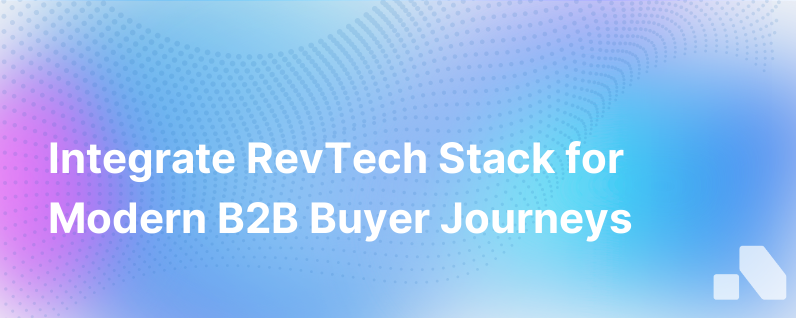Connect Your Revtech Stack For New B2B Buyer Journeys
Published on October 15, 2023 by David Zhang
In the fast-evolving world of B2B sales, buyer journeys are becoming increasingly complex. As potential customers skip haphazardly between channels and touchpoints, it’s crucial for B2B marketers to ensure their revenue technology stack – or RevTech stack – is intricately connected to deliver a seamless and intuitive buyer journey.
The landscape of B2B sales has changed. Prospects no longer follow a predictable path from awareness to decision; they embark on a winding expedition, demanding personalized experiences and pertinent information at every turn. Ensuring that your RevTech stack is connected and aligned with these new buyer behaviors is not just a priority, it's a necessity for survival.
In this detailed article, we will dissect what it means to connect your RevTech stack, its significance in catering to modern buyer journeys, and actionable insights for synthesizing your sales and marketing tools.
Connect the RevTech Dots: Integration is Key for Synergy
The RevTech stack is an amalgamation of all the technological tools a company uses to guide the prospect through the sales funnel; it typically includes CRM systems, marketing automation tools, sales enablement platforms, customer success software, data analytics programs, and more.
Historically, these systems have been siloed, with limited interaction. But today’s sophisticated B2B buyer won’t tolerate fragmented experiences. They expect consistency, whether they’re engaging with your website, reading your emails, or speaking directly with your sales team.
This is where seamless integration becomes critical. When your RevTech stack is fully connected, data flows unhindered between systems, unlocking potent insights and enhancing customer experiences. Each tool in your stack should not only serve its primary function but also complement and enrich the others.
For example, your marketing automation should feed into your CRM, which then connects to your sales enablement platform. This unified approach ensures that the buyer’s interactions with your brand are consistent, accurate, and personalized, no matter the channel.
Importance of a Synchronized RevTech Stack for B2B Buyer Journeys
- Data Consistency and Transparency: With integrated systems, sales and marketing teams have a holistic view of the buyer’s journey. Every touchpoint is tracked, enabling a coherent narrative of the prospect's journey.
- Personalization at Scale: Rich, connected data allows for hyper-personalized marketing and sales outreach, tailored to the specific needs and behaviors of each prospect.
- Agility and Responsiveness: A connected RevTech stack provides the ability to quickly pivot strategies and tactics based on real-time insights, allowing businesses to stay ahead of the changing preferences of B2B buyers.
- Increased Efficiency and Productivity: Automating tasks and workflows across the stack reduces manual entry and error, and frees up your team to focus on higher-level strategy and relationship building.
- Improved Customer Experiences: When all your systems communicate effectively, there's no room for the kind of disjointed experiences that can turn potential buyers away.
Building a Connected RevTech Stack for the New B2B Buyer
-
Audit Your Current Technology Mix: Understand what tools you have, how they're being used, and where there might be gaps or overlaps in functionality. Streamlining your stack to include only those tools that offer unique value is a crucial first step.
-
Emphasize Integration Capabilities: When evaluating new tools, prioritize those that offer open APIs and have a history of successful integrations with other systems in your stack.
-
Develop a Data Management Strategy: With multiple systems, comes great responsibility for managing the flow and integrity of data. Define clear processes to ensure that data entered in one system will sync correctly with others.
-
Leverage Artificial Intelligence and Machine Learning: Advanced AI can analyze customer data and provide predictive insights, suggesting next steps for personalization and engagement that human marketers might miss.
-
Train Your Teams: Ensure that sales, marketing, and customer success teams understand how to leverage the connected tools at their disposal to create those seamless buyer experiences.
-
Adopt Customer Data Platforms (CDP): Consider utilizing a CDP to unify your customer data from various sources, enabling a single, comprehensive view of customer interactions across all channels.
-
Test and Optimize Continuously: Evolving buyer journeys require an agile approach. Regularly optimize your workflows and integrations based on performance data and feedback.
Case in Point: Real-Life Benefits of a Connected RevTech Stack
Picture this: a prospect visits your website, downloading an eBook. Your marketing automation tool captures their information and interest area, nudging the lead into your CRM system. Your sales enablement platform then offers your sales team content tailored to that eBook topic, which can be used during outreach. This consistent thread of content and interest propels the prospect smoothly towards a sale.
Another scenario involves customer support. When support software is synced with your CRM, sales can be aware of any issues a prospect or customer is facing in real-time, allowing for proactive measures to maintain and build the relationship.
Conclusion
As the B2B buyer journey continues to evolve, so too must our RevTech stacks. By connecting each technological component, we not only gain a panoramic view of our prospects' journeys but also position ourselves to respond nimbly with personalized, data-driven interactions that resonate deeply.
This connected ecosystem offers an unparalleled ability to meet and exceed the expectations of the modern B2B buyer, delivering exceptional experiences that drive engagement, foster trust, and ultimately, close deals. It's in this interplay of data, insights, and personalization where companies can truly differentiate themselves, and it’s tools like Aomni that can offer the intelligence and integration needed to orchestrate these aligned buyer journeys.